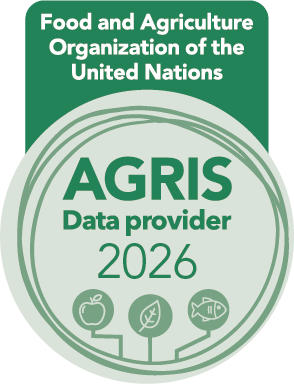RECENT ADVANCES IN ROOTSTOCK BREEDING OF MANGO
DOI:
https://doi.org/10.24154/jhs.v19i2.2362Keywords:
Abiotic stress, alternate bearing, biotic stress, productivity, rootstockAbstract
The mango stands as the foremost and highly favored fruit grown in tropical as well as subtropical regions due to its exceptional versatility, superior nutritional value, captivating flavor and aroma. Despite its prominence, mango yields fall short compared to other fruit crops due to factors like low-density planting, the use of seedling rootstocks, and alternate bearing. A significant hindrance to widespread mango production is the impact of biotic and abiotic stress, which hampers plant growth, leading to eventual plant death. Mitigating this challenge requires a focus on breeding for an ideal rootstock development. This paper delves into the current landscape of rootstock breeding in various regions worldwide, exploring its critical role in shaping the health, growth, and productivity of mango trees.
Key Words
Abiotic Stress, Alternate Bearing, Biotic Stress, Productivity, Rootstock and Versatility
Downloads
References
Carvalho, C. R. L., Rossetto, C. J., Mantovani, D. M. B., Morgano, M. A., Castro, J. V. D., & Bortoletto, N. (2004). Evaluation of mango cultivars selected by “Instituto Agronomico de Campinas” compared to others of commercial importance. Revista Brasileira de Fruticultura, 26, 264–271. https://doi.org/10.1590/S0100-29452004000200021
Damodaran, T., Rajan, S., Jha, S. K., Misra, V. K., & Sahu, A. (2018). Screening polyembryonic mango accessions for salt tolerance and assessing dynamics of sodium (Na+), potassium (K+), and antioxidants. Fruits, 73(4), 228–235. https://doi.org/10.17660/th2018/73.4.4
Dayal, V., Dubey, A. K., Singh, S. K., Sharma, R. M., Dahuja, A., & Kaur, C. (2016). Growth, yield and physiology of mango (Mangifera indica L.) cultivars as affected by polyembryonic rootstocks. Scientia Horticulturae, 199, 186–197. https://doi.org/10.1016/j.scienta.2015.12.042
Dubey, A. K., Manish, S., Sharma, Y. K., Pandey, R. N., & Deshmukh, P. S. (2007). Dry mass production and distribution of nutrients in two mango rootstocks as affected by salinity. Indian Journal of Horticulture, 64(4), 385–390.
Dubey, A. K., Sharma, R. M., Deepak, & Amrenderkumar. (2021). Long term performance of mango varieties on five polyembryonic rootstocks under subtropical conditions: Effect on vigour, yield, fruit quality and nutrient acquisition. Scientia Horticulturae, 280, 109944. https://doi.org/10.1016/j.scienta.2021.109944
Duran Zuazo, V. H., Martinez-Raya, A., & Aguilar Ruiz, J. (2003). Salt tolerance of mango rootstocks (Mangifera indica L. cv. Osteen). Spanish Journal of Agricultural Research, 1(1), 67–78. https://doi.org/10.5424/sjar/2003011-10
Duran Zuazo, V. H., Pleguezuelo, C. R. R., & Tarifa, D. F. (2006). Fruit yield, growth and leaf nutrient status of mango trees grafted on two rootstocks in a marginal growing area (South-East Spain). Fruits, 61, 163–170. https://doi.org/10.1051/fruits:2006014
Galán Sauco, V. (2019). Mango rootstock: A review. Acta Horticulturae, 1244, 1–10. https://doi.org/10.17660/ActaHortic.2019.1244.1
Gawankar, M. S., Salvi, B. R., Chavan, S. A., & Dalvi, N. V. (2010). Comparative performance of mango varieties grafted on Vellaikolamban and mixed rootstock. Journal of Horticultural Science, 5(2), 114–116. https://doi.org/10.24154/jhs.v5i2.456
Gazit, S., & Kadman, A. (1980). Mango rootstock selection. Horticultural Science, 15(5), 669. https://doi.org/10.21273/HORTSCI.15.5.669
Iyer, C. P. A., & Degani, C. (1997). Classical breeding and genetics. In R. E. Litz (Ed.), The mango: Botany, production and uses (pp. 49–68). CAB International.
Iyer, C. P. A., & Kurian, R. M. (1992). Stem anatomical characters in relation to tree vigour in mango (Mangifera indica L.). Scientia Horticulturae, 50, 245–253. https://doi.org/10.1016/0304-4238(92)90177-E
Iyer, C. P. A., & Subramanyam, M. D. (1986). Creeping, a promising genotype for introduction of dwarfness in mango. Indian Journal of Horticulture, 43, 221–223.
Kadman, A., Gazit, S., & Ziv, G. (1975). Selection of mango rootstocks for adverse water and soil conditions in arid areas. Acta Horticulturae, 57, 81–87. https://doi.org/10.17660/ActaHortic.1976.57.10
Majumdar, P. K., Chakladar, B. P., & Mukherjee, S. K. (1972). Selection and classification of mango rootstocks in the nursery stage. Acta Horticulturae, 24, 101–106. https://doi.org/10.17660/ActaHortic.1972.24.17
Martinez, A. R., Peralta-Antonio, N., Rebolledo-Martinez, L., Becerril-Roman, E. A., & Rebolledo-Garcia, R. L. (2019). Effect of rootstock in tree growth, dry matter, flowering, yield and quality of ‘Manila’ mango. Scientia Horticulturae, 251, 155–161. https://doi.org/10.1016/j.scienta.2019.03.012
Mizani, A., Bally, I., Ibell, P. T., Wright, C., Maddox, C., & Kolala, R. (2018). Identifying vigour controlling rootstocks for mango. Acta Horticulturae, 1228, 167–174. https://doi.org/10.17660/ActaHortic.2018.1228.25
Morsy, M. H. (2003). Growth ability of mango cultivars irrigated with saline water. Acta Horticulturae, 609, 475–482. https://doi.org/10.17660/ActaHortic.2003.609.73
Nimbolkar, P. K., Kurian, R. K., Upreti, K. K., Laxman, R. H., & Varalakshmi, L. R. (2018). Seed germination and seedling growth responses of polyembryonic mango (Mangifera indica L.) genotypes to salinity stress. International Journal of Chemical Studies, 6(2), 3641–3648. https://doi.org/10.13140/RG.2.2.21124.55682
Normand, F., Lauri, P. E., & Legave, J. M. (2015). Climate change and its probable effects on mango production and cultivation. Acta Horticulturae, 1075, 21–32. https://doi.org/10.17660/ActaHortic.2015.1075.1
Om Prakash, & Srivastava, K. C. (1987). Mango diseases and their management: A world review. In Review of Tropical Plant Pathology (Supplement No. 1, p. 175). Today and Tomorrow’s Printers & Publishers.
Palaniappan. (2001). Germplasm screening for salinity stress in tropical fruit species. In Regional training course on characterization, evaluation and conservation of tropical fruits genetic resources (Organized by IPGRI, ICAR and IIHR).
Pandey, P., Singh, A. K., Dubey, A. K., & Dahuja, A. (2014). Biochemical and salt ion uptake responses of seven mango (Mangifera indica L.) rootstocks to NaCl stress. Journal of Horticultural Science & Biotechnology, 89(4), 367–372. https://doi.org/10.1080/14620316.2014.11513094
Perera-Castro, A. V., Hernandez, B., Grajal-Martin, M. J., & Gonzalez-Rodriguez, A. M. (2023). Assessment of drought stress tolerance of Mangifera indica L. autotetraploids. Agronomy, 13, 277. https://doi.org/10.3390/agronomy13010277
Pinto, A. C. Q., & Byrne, D. H. (1993). Mango hybridization studies in tropical savannah (cerrados) of Brazil central region. Acta Horticulturae, 341, 98–106. https://doi.org/10.17660/ActaHortic.1993.341.9
Reddy, Y. T. R., Kurian, R. M., Ramachander, P. R., Singh, G., & Kohli, R. R. (2003). Long-term effects of rootstocks on growth and fruit yielding patterns of ‘Alphonso’ mango (Mangifera indica L.). Scientia Horticulturae, 97, 95–108. https://doi.org/10.1016/S0304-4238(02)00025-0
Rossetto, C. J., Ribeiro, I. J. A., Gallo, P. B., Soares, N. B., Sabino, J. C., Martins, A. L. M., Bortoletto, M., & Paulo, E. M. (1997). Mango breeding for resistance to diseases and pests. Acta Horticulturae, 455, 299–304. https://doi.org/10.17660/ActaHortic.1997.455.39
Rossetto, C. J., & Ribeiro, I. J. A. (1990). Mango wilt. XII. Recommendations for control. Revista de Agricultura (Piracicaba), 65, 173–180.
Singh, N. P., Srivastava, R. P., & Chadha, K. L. (1986). Screening of dwarfing mango rootstocks at nursery stage on the basis of anatomical characters. Indian Journal of Horticulture, 43, 18–22.
Sharma, D. K., & Majumder, P. K. (1988). Further studies on inheritance in mango. Acta Horticulturae, 231, 106–111.
Vargas-Ramos, V. H., Pinto, A. C. Q., Junqueira, N. T. V., Gomes, A. C., Andrade, S. M. R., & Cordeiro, M. C. R. (2014). Effect of mono and polyembryonic rootstocks on growth, yield and fruit quality of four mango cultivars in the central region of Brazil. Acta Horticulturae, 645, 201–207. https://doi.org/10.17660/ActaHortic.2004.645.18
Vazquez-Luna, A., Rivera-Cabrera, F., Perez-Flores, L. J., & Diaz-Sobac, R. (2011). Effect of rootstock on mango fruit susceptibility to infestation by Anastrepha obliqua. Journal of Economic Entomology, 104(6), 1991–1998. https://doi.org/10.1603/ec11223
Downloads
Published
Issue
Section
License
Copyright (c) 2024 N R Sinchana Jain, M Sankaran, M R Dinesh (Author)

This work is licensed under a Creative Commons Attribution-NonCommercial-ShareAlike 4.0 International License.
Authors retain copyright. Articles published are made available as open access articles, distributed under the terms of the Creative Commons Attribution-NonCommercial-ShareAlike 4.0 International License, which permits unrestricted non-commercial use, distribution, and reproduction in any medium, provided the original author and source are credited. 
This journal permits and encourages authors to share their submitted versions (preprints), accepted versions (postprints) and/or published versions (publisher versions) freely under the CC BY-NC-SA 4.0 license while providing bibliographic details that credit, if applicable.







 .
. 











